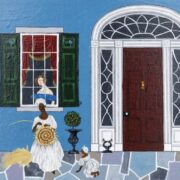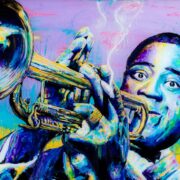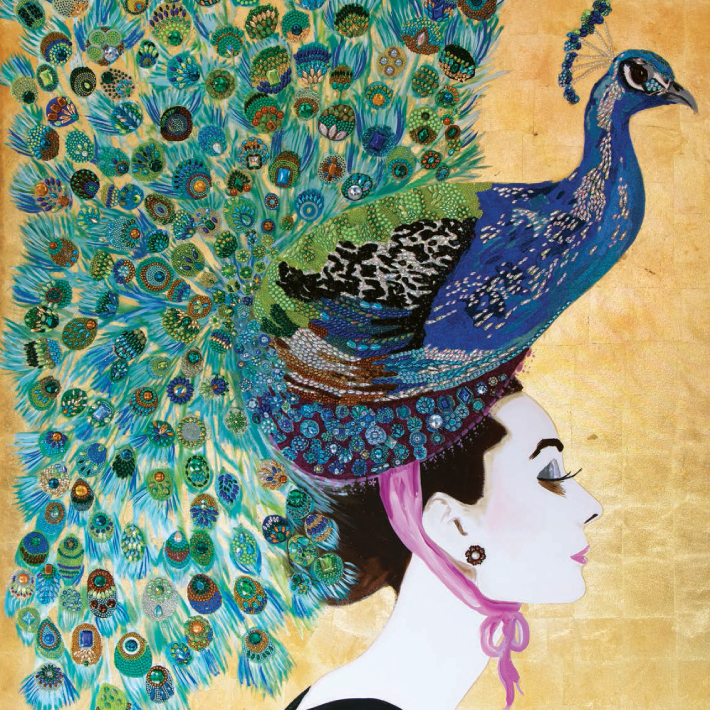Shooting for the Stars: Photographer Skip Bolen

by Leslie Cardé
HE’S WORKED IN NEW ORLEANS, New York, and L.A., but as a boy growing up in Lafayette, Louisiana, the world of movie-making wasn’t something he was at all familiar with. But, like everything else in his life, Skip Bolen’s journey into photographing famous film stars was
something he ambled into, quite by happenstance.
I first met Skip years ago on the set of the Russell Crowe movie “Unhinged,” which was shooting that day in Chateau Estates, filming a particularly hairy car crash, replete with an airborne vehicle, a launch ramp and a crane. I was doing a piece about the film for the New Orleans Advocate, and Skip had been hired by the motion picture studio to get some spectacular promotional publicity stills.
That was three years ago, and Bolen has now been back in New Orleans for the last 15 years, on the set of some 93 films, but this wasn’t ever how he originally envisioned his career going.
“Believe it or not, I wanted to be a dancer,” remembered Bolen. “But, I couldn’t translate that into making a living and paying the rent. I studied applied art in college, figuring I’d do fine art on the side. So, the logical step out of college was to take a job at an ad agency in Lafayette.”
Eventually realizing he needed to move to a bigger city, Bolen packed his bags and headed for New Orleans, where he took a job at a small design studio. But he didn’t enjoy working on products he didn’t believe in, so in time moved to Wavelength Magazine, a precursor to OffBeat Magazine, which became the definitive guide to music in Louisiana and New Orleans. At Wavelength, he became the art director. It satisfied his love of music as a guitarist and songwriter, who was at the time in a punk band.
Meanwhile, he began to photograph musicians. His first gig? The Ramones, appearing at a West Bank venue with Iggy Pop. And he was showing his films of the musicians at a studio he rented on Poydras Street where the first floor became a venue for bands, and the second floor was an art studio. The total tab for the two floors he rented was $100. It was 1979 in New Orleans, and rents were still relatively cheap. But Bolen’s desire to work in a very large city lured him to New York, where rents were anything but.
Hopping in his Peugeot, he headed for the Big Apple with relatively little money and no job. He was decidedly betting on the come. Sleeping on a friend’s couch, he began sending out resumés and interviewing everywhere from MTV to Condé Nast, which published everything from Vogue and The New Yorker to GQ and Vanity Fair. But what job openings they had weren’t a good fit with Bolen’s talents.
Eventually hooking up with a friend who’d lived in New Orleans where he worked on Mardi Gras floats, Bolen learned there was a new club in Tribeca called Area where his buddy had worked. His friend wondered if he’d be interested in working there himself. It was the decadent 80’s and this was to be the follow-up to Studio 54, which had closed in 1980 and was the hip hangout for the likes of Liza Minnelli and Halston. With a studio on the second floor for artists and the club at street level, this seemed like a better fit. With themes in the club changing every month, there were art installations to be prepared by designers… right up Bolen’s alley.
“There was a party for filmmaker Federico Fellini one evening, with everything painted white, including the naked young men and women painted from head to toe and swinging from the ceiling,” detailed Bolen. “Another night it was a slumber party with Boy George, with a fabulous breakfast served the next morning. There was always an A-List opening night, where people like Andy Warhol, Basquiat, and David Bowie came to hang out and be seen.”
All of the avant-garde clubs had a shelf life, and Area closed in 1987, while Bolen moved on to Guitar World, a monthly music magazine, where he stayed for three years. But, rumor had it that there was a job opening at Condé Nast. So, he brought his portfolio, and before he knew it he was interviewing with Anna Wintour.
“Somehow, I didn’t think it had gone well,” said Bolen. “She was embarking on the transformation of House & Garden magazine to the trendier “HG.” She asked what my favorite magazines were, and then abruptly announced she was taking off for a meeting. As we both headed for the door (I couldn’t wait to get out of there), we collided, when she turned to me and said she’d be talking to me soon. Sure, I thought, and caught a cab back to my place. The next morning, I got the call that I was hired.”
Serendipity was at work again. Bolen loved the work, and was learning from the best. Ukrainian-born Alex Liberman was a painter, photographer, and sculptor whose work was in the Metropolitan Museum of Art. His stories about hanging out with Picasso were legendary, and Bolen flourished in this environment. But HG, which attempted to be a mix of fashion and style with design and decorating, had very shortly been dubbed “Hot Gossip” and was losing its longstanding House & Garden reader base. It had become a fashion magazine, with models dressed in designer duds, and film stars pontificating about architecture. Meanwhile, Wintour had one foot out the door, with bigger fish to fry.
“When we all became aware that she was going to Vogue, I should have told her I wanted to go with her,” recalled Bolen. “But, I didn’t.”
Never one to sit still, Bolen had gone into clothing design, selling his wares at trade shows and making big inroads in the Japanese marketplace. The Asian company who was his primary client was based in Southern California. It was an enterprise that went on for seven years, but it became too big for Bolen to continue without a major expansion.
It was time to move on.
Next stop, a move to California, and a job at the House of Blues, where he became the art director, based at the Sunset Boulevard location. The music venue was starting to expand across the country, and Bolen was on the cutting edge as the group would discover bands, and package the artists to go to all of the House of Blues clubs nationwide. Bolen managed the art direction for those promotions, while the club ventured into the recording business, starting their own label. For the artist, who now had seven designers working for him, was living in Beachwood Canyon under the Hollywood sign, and was hearing the great sounds of bands like The Who wafting over the hills from the Hollywood Bowl, life was sweet.
And, as fate would have it, there was more on the horizon. Approached by a man while he was shooting a band on stage at The House of Blues, the gentleman wanted to know if he was interested in making some money. He wanted Bolen to shoot celebrities for WireImage (soon to be acquired by Getty Images). So, it was House of Blues during the day and red carpets at night.
But the rumors were flying that a takeover of the House of Blues was imminent, and without warning, Bolen was called into his boss’s office and told the company was being acquired by Live Nation Entertainment. In the process, they’d be letting go of eight mid-level managers, including Bolen. He had projects to finish, but within six weeks he would no longer be a part of the House of Blues.
Still doing work for WireImage in the beginning of 2006, and still reeling from the devastation which had occurred in New Orleans from Hurricane Katrina, he decided to return to the Crescent City.
“I wanted to come back for the rebuild, and document bringing the city back,” said Bolen. “There were National Guard trucks cruising the streets, Brad Pitt was rebuilding the Lower Ninth Ward, and there was a lot happening in the city.”
Although Bolen didn’t know it at the time, that fateful decision to return to New Orleans would be a turning point in his life. He was getting a reputation as the go-to guy for celebrity photos. Although not exactly kosher, and shooting without explicit permission from the celebrities’ people, he had taken extraordinary photos of Prince at the Foundation Room inside The House of Blues. Discovered by Prince’s handlers, he was told to turn over the cards in his camera.
They didn’t care that he was an employee of The House of Blues—he didn’t have permission from Prince. He turned over only some of the cards from his camera, and held onto the rest of the photos, which weren’t released for some time to come.
Years later, he would shoot Beyoncé at the Essence Fest from the photo pit… without permission.
“I’m shooting from ten rows back, between two people’s heads, and thought I’d be lucky just to get a couple of wardrobe changes,” remembered Bolen. “She did ten wardrobe changes before Beyoncé’s managers discovered me and wanted me out of there. I had gotten great shots of the singer for Getty Images, and they were eventually posted to the internet.”
But the key to Bolen’s present career was about being in the right place at the right time. Strolling down a street in New Orleans in 2007, he noticed a lot of trucks and cameras on the street, and discovered it was a motion picture shoot. Never without his camera, he began taking behind-the-scenes photos. Telling the director he worked for Getty, the production folks wanted to see the photos. They liked what they saw. But, they made it clear that without a union card, the studios couldn’t hire him for other productions. With a Fox shoot on the horizon in New Orleans, and Bolen being one of the few photographers living in the city post-Katrina, the director arranged for Bolen to get a union card. The rest is history.
“Becoming a still photographer in Los Angeles seemed out of reach, because it’s a very cliquey club,” explained Bolen. “But, I fell into this.”
It began with a Lifetime film with Harry Connick, where he was hired to do behind-the-scenes photos. While everyone else was there to make the film, Bolen’s job was part of advertising, publicity, and promotion. Getting that money shot of one of the stars in a key scene is what he was paid to do. And, getting the cooperation of the actors and the crew was critical.
“At this stage of the game, I knew all of the cinematographers, so they let me get right up against the camera, trusting me not to bump it,” said Bolen. It’s a very privileged world and I’m lucky to be a part of it.”
Having a symbiotic relationship with the actors is often critical to getting a great shot. And, in fact, lurking around the set while actors are actually delivering lines can be disturbing to some actors.
“Once upon a time, Faye Dunaway noticed me taking photos while she was in the middle of a scene and ordered me off the set,” said Bolen. “It can be tricky, because shooting stills while people are talking can catch them in the middle of a blink, or with a contorted facial expression, and I’m very mindful of this. But, in this case, when the director yelled “cut,” she signaled for me to come over, and she recreated the scenes for me, and we got some excellent stuff… because she trusted me. It’s my job to form a bond with the actors, so that they know we’re all on the same page, and have the same goal. I’m not some paparazzo who roams onto the set and is trying to get photos of celebrities in compromising positions, or at their worst.”
Those bonds have been formed with actors like Jamie Foxx and Matthew McConaughey, who both go out of their way to make his job easy. Bryan Cranston, here in New Orleans for the “Your Honor” shoot, which will be back for another season, has taken to calling Bolen “Agent 13″… a reference to the fictional character in the Marvel Comics, who’s a secret agent. For his stealthy behavior on set, popping out from behind every door to get a great shot, Cranston thought this an apropos moniker.
Bolen loves the variety of films he’s on. This year’s “The Thing About Pam” with Renée Zellweger produced some interesting shots of the actress in head-to-toe prosthetics. She looked so different that when Bolen saw her without her costume, he didn’t recognize her. Protecting Zellweger from the hovering paparazzi became a full-time job of the crew, who eventually circled the wagons around the set with tall equipment so that one particular paparazzo who’d booked a hotel room across from the production set on St. Charles Avenue couldn’t see anything. Never a dull moment on a set.
Most of Bolen’s film shoots take place in New Orleans and the surrounding areas, but once in a while, a studio that has used him in the past will request him on a particular out-of-town shoot. Such was the case on the reboot of “Dallas,” shot entirely in Texas. He became friendly with the cast members, noting that Linda Gray was giving massages on the set during downtime, and eventually spilled that the leg in the famous “Graduate” film poster with Dustin Hoffman was actually hers, not Anne Bancroft’s.
The “Dallas” cast was sent into shock when actor Larry Hagman, who played the infamous J.R. Ewing, died while the show was being shot. They wrote his death into the show, and at the funeral were all of the women J.R. had ever been involved with. Titled “The Women of J.R.,” it’s one of Bolen’s favorite photographs.
“I’m now full-time in the film industry and don’t do music gigs any longer,” said Bolen. “I have longevity. I’m shooting the 7th season now of “Queen Sugar,” the Oprah Winfrey production. I’ve become friendly with the cast and crew over the years. There’s something about the camaraderie in this industry that I love. Sometimes you just know that you’ve finally found your niche in life.”
Email Leslie Cardé at leslieinolamag@gmail.com.







